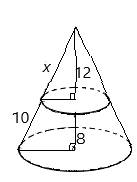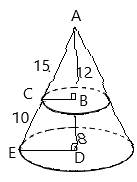
a.
To calculate: The value of x .
a.
Answer to Problem 14PSB
The value of x is
Explanation of Solution
Given information:
Height of small cone = 12,
Slant height of small cone = x ,
Height of large cone
Slant height of large cone
Formula used:
The below property is used:
Corresponding sides of similar
Calculation:

The smaller triangle is similar to the whole triangle by AA similarity rule, so
Corresponding sides of similar triangles are congruent.
b.
To find: The radii of the
b.
Answer to Problem 14PSB
The radii are 9 and 15.
Explanation of Solution
Given information:
Height of small cone = 12,
Slant height of small cone = x ,
Height of large cone
Slant height of large cone
Formula used:
The below property is used:
Corresponding sides of similar triangles are congruent.
The below theorem is used:
Pythagoras theorem states that “In a right angled triangle, the square of the hypotenuse side is equal to the sum of squares of the other two sides”.

In right
Calculation:

The smaller triangle is similar to the whole triangle by AA similarity rule, so
Corresponding sides of similar triangles are congruent.
Radius of small circle:
Side BC can be calculated by applying Pythagoras Theorem.
In right angled triangle ABC , we get
Radius of large circle:
Side ED can be calculated by applying Pythagoras Theorem.
In right angled triangle ADE , we get
c.
To calculate: The volume of smaller cone.
c.
Answer to Problem 14PSB
The volume of smaller cone is
Explanation of Solution
Given information:
Height of small cone = 12,
Slant height of small cone = x ,
Height of large cone
Slant height of large cone
Formula used:
The below property is used:
Corresponding sides of similar triangles are congruent.
The below theorem is used:
Pythagoras theorem states that “In a right angled triangle, the square of the hypotenuse side is equal to the sum of squares of the other two sides”.

In right angle triangle,
Volume of cone
B = Base area of cone and h = height of cone
Area of a circle:
r = radius of circle
Calculation:

The smaller triangle is similar to the whole triangle by AA similarity rule, so
Corresponding sides of similar triangles are congruent.
Radius of small circle:
Side BC can be calculated by applying Pythagoras Theorem.
In right angled triangle ABC , we get
Volume of cone
Volume of smaller cone
Volume of smaller cone
Volume of smaller cone
d.
To calculate: The volume of larger cone.
d.
Answer to Problem 14PSB
The volume of larger cone is
Explanation of Solution
Given information:
Height of small cone = 12,
Slant height of small cone = x ,
Height of large cone
Slant height of large cone
Formula used:
The below property is used:
Corresponding sides of similar triangles are congruent.
The below theorem is used:
Pythagoras theorem states that “In a right angled triangle, the square of the hypotenuse side is equal to the sum of squares of the other two sides”.

In right angle triangle,
Volume of cone
B = Base area of cone and h = height of cone
Area of a circle:
r = radius of circle
Calculation:

The smaller triangle is similar to the whole triangle by AA similarity rule, so
Corresponding sides of similar triangles are congruent.
Radius of large circle:
Side ED can be calculated by applying Pythagoras Theorem.
In right angled triangle ADE , we get
Volume of cone
Volume of larger cone
Volume of larger cone
Volume of larger cone
e.
To calculate: The volume of the frustum.
e.
Answer to Problem 14PSB
The volume of the frustum is
Explanation of Solution
Given information:
Height of small cone = 12,
Slant height of small cone = x ,
Height of large cone
Slant height of large cone
Formula used:
The below property is used:
Corresponding sides of similar triangles are congruent.
The below theorem is used:
Pythagoras theorem states that “In a right angled triangle, the square of the hypotenuse side is equal to the sum of squares of the other two sides”.

In right angle triangle,
Volume of cone
B = Base area of cone and h = height of cone
Area of a circle:
r = radius of circle
Calculation:

The smaller triangle is similar to the whole triangle by AA similarity rule, so
Corresponding sides of similar triangles are congruent.
Radius of small circle:
Side BC can be calculated by applying Pythagoras Theorem.
In right angled triangle ABC , we get
Volume of cone
Volume of smaller cone
Volume of smaller cone
Volume of smaller cone
Radius of large circle:
Side ED can be calculated by applying Pythagoras Theorem.
In right angled triangle ADE , we get
Volume of cone
Volume of larger cone
Volume of larger cone
Volume of larger cone
Volume of frustum = Volume of larger cone − Volume of smaller cone
Volume of frustum
Volume of frustum
Volume of frustum
Chapter 12 Solutions
Geometry For Enjoyment And Challenge
Additional Math Textbook Solutions
A First Course in Probability (10th Edition)
Elementary Statistics
College Algebra (6th Edition)
An Introduction to Mathematical Statistics and Its Applications (6th Edition)
Introductory and Intermediate Algebra for College Students (5th Edition)
 Elementary Geometry For College Students, 7eGeometryISBN:9781337614085Author:Alexander, Daniel C.; Koeberlein, Geralyn M.Publisher:Cengage,
Elementary Geometry For College Students, 7eGeometryISBN:9781337614085Author:Alexander, Daniel C.; Koeberlein, Geralyn M.Publisher:Cengage, Elementary Geometry for College StudentsGeometryISBN:9781285195698Author:Daniel C. Alexander, Geralyn M. KoeberleinPublisher:Cengage Learning
Elementary Geometry for College StudentsGeometryISBN:9781285195698Author:Daniel C. Alexander, Geralyn M. KoeberleinPublisher:Cengage Learning

